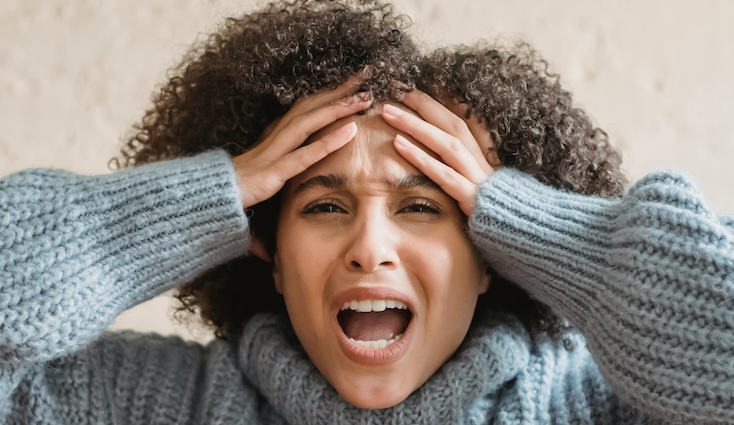Salmonella is one of the most common food poisonings that you may have. This disease causes symptoms such as diarrhea, fever, and stomach pain and may affect you for a few days. Of course, Salmonella is not only transmitted through food, and animals also play a role in the spread of this disease. Do you know how to diagnose Salmonella or prevent this widespread disease? To learn more about this disease, stay with us until the end of the article.
What is Salmonella?
Salmonella is an infection caused by Salmonella bacteria. It is also called salmonellosis to separate this infection from other diseases caused by salmonella bacteria, such as typhoid fever.
When you get this disease, your body has so many bacteria that they escape from stomach acid and the immune system and cause your illness. Salmonella bacteria attack and destroy the intestinal lining cells. As a result, it becomes difficult for the body to absorb water, and stomach contractions occur. Body water is also excreted in the form of diarrhea.
What are people more exposed to this poisoning?
Anyone can get Salmonella, but age, living conditions, illnesses, and certain medical conditions increase the chance of developing an infection or severe disease, including:
- Living with animals such as chickens, ducks, turtles, and lizards.
- Taking certain drugs such as cancer drugs or steroids that weaken the immune system.
- Taking antacids that increase the probability of bacteria surviving in the stomach by reducing stomach acid.
- Taking antibiotics that destroy the good bacteria in the gut and make it harder to fight infection.
- Having an inflammatory bowel disease that increases the likelihood of infection.
- International travel, especially to areas with poor sanitation.
- Being less than five years old.
In some cases, you are more likely to develop a severe salmonella infection, including:
- Age over 65 years and under 12 months.
- A compromised immune system is caused by HIV, chemotherapy, or other diseases and treatments.
- Sickle cell disease.
Cause of Salmonella

The most common way to get Salmonella is to eat undercooked foods, including:
- Consuming raw or undercooked meat, chicken, eggs, and seafood.
- Consumption of contaminated fruits and vegetables.
- Drinking contaminated water or unpasteurized milk and cheese.
- Eating processed foods like chicken nuggets and nut butter.
- Sitting hands while preparing food and consuming it.
You may also get this disease through contact with an animal or person infected with salmonella bacteria. Salmonella is found in poultry and other animal species, including:
- Amphibians (frogs and toads);
- Reptiles (turtles, lizards, and snakes);
- birds (chickens, ducks, turkeys, and wild birds);
- farm animals (cows, goats, sheep, and pigs);
- Pets (guinea pigs, dogs, cats, birds, and small animals).
Salmonella symptoms
Symptoms of salmonella poisoning may appear from a few hours to a few days after contact with salmonella bacteria and usually disappear within a few days. These symptoms involve your stomach and intestines. You may have all or any of the following symptoms:
- diarrhea;
- then;
- Stomach pain and cramps;
- Nausea and vomiting ;
- headache _
Side effects of Salmonella
Most people do not develop side effects from Salmonella. However, possible complications include dehydration, bacteremia, osteomyelitis, and reactive arthritis.
1. dehydration
If the body fluids are not replaced, the person may suffer severe dehydration, and this issue endangers the person’s life. If these symptoms occur, you should see a doctor:
- confusion;
- Dark or less dark stools or urine than usual;
- dizziness and weakness or lightheadedness;
- dry mouth or throat;
- increased heart rate;
- loss of appetite ;
- red skin;
- muscle cramp;
- Trembling ;
- constipation _
2. Bacteremia or sepsis
Salmonella can spread the infection to other organs and tissues if it enters the bloodstream. This may lead to inflammation of the bones, joints, brain lining, heart, or heart valves. Bacteremia can cause sepsis. When the immune system attacks the body, a person’s life is in danger.
3. Salmonella osteomyelitis
A person with sickle cell disease is more likely to develop a rare Salmonella infection called osteomyelitis. Therefore, if these symptoms occur, see a doctor:
- back or bone pain;
- pain that makes movement difficult;
- Swelling, redness, or fluid accumulation in a part of the body.
4. Reactive inflammation
Sometimes the body mistakenly attacks a part of the body to fight the disease. Reactive arthritis causes swelling in the lower back, joints, and eyes. Symptoms of reactive inflammation include:
- lower back pain;
- joint pain, stiffness, or swelling;
- Frequent urination;
- burning sensation when urinating;
- Jaundice ;
- diarrhea and abdominal pain;
- Mouth ulcers;
- boil
Time to see a doctor

See a doctor if the illness does not disappear within a few days or if you become dehydrated and have some symptoms. These symptoms include:
- High fever;
- blood in the stool;
- Excessive vomiting that prevents eating and drinking;
- Dark or less dark stools or urine than usual;
- dry mouth or throat;
- Feeling dizzy when standing.
Salmonella diagnosis
Salmonella is diagnosed by stool, blood, or biopsy. The doctor may also perform a physical examination and ask you questions.
Salmonella treatment
Salmonella is usually not treated with medication. Of course, if the disease is severe or the risk of side effects is high, the doctor may prescribe antibiotics. If you have severe diarrhea, you may need to be hospitalized. You should also drink lots of fluids and apply serum to compensate for dehydration.
Drugs used
If antibiotics are needed to treat Salmonella, the doctor may prescribe these drugs:
- ciprofloxacin;
- ceftriaxone;
- sulfamethoxazole trimethoprim;
- Azithromycin.
Salmonella home treatment
The most important way to treat Salmonella is to drink plenty of fluids to prevent dehydration, including:
- Water;
- sports drinks;
- natural fruit juice with water;
- broth;
- Oral water reabsorption solutions such as Pedialyte.
Also, over-the-counter drugs such as loperamide or bismuth subsalicylate can stop diarrhea in adults.
Avoid arbitrarily giving diarrhea medicines to children and babies.
Salmonella prevention

Cooking and pasteurization kill Salmonella in food. Also, by doing a few simple things, the possibility of getting poisoned is reduced, including:
- If you are sick, do not cook for others.
- Always wash your hands with soap and water after going to the bathroom.
- Always wash your hands with soap and water before and after preparing food and eating it.
- Wash food preparation and consumption utensils before and after use.
- Cook the food at the right temperature before consuming it.
- Avoid touching other foods when handling raw meat, poultry, seafood, and eggs.
- Wash or peel vegetables and fruits before cutting, eating, or cooking them.
- Freeze meat, poultry, and seafood faster.
- Do not use milk or foods containing unpasteurized dairy.
- Do not use untreated water or food containing untreated water. If you are unsure if the water is purified, use mineral water.
Most animals have salmonella infection or carry it in their fur, feathers, and skin. An infected animal does not necessarily look sick. By doing some simple methods, you can prevent the disease from animals:
- After touching the animal or related items, wash your hands with soap and water.
- After touching the animal, please do not put your hand in your mouth or kiss its feathers, fur, skin, and body.
- If you have a weak immune system, are over 65, or your child is under 5, do not contact high-risk animals.
- Avoid eating and drinking near dangerous animals or their habitat.
- Clean up as much pet stuff as possible outside the home. The kitchen sink is not a good place for this.
Common questions
1. How common is Salmonella?
Salmonella is the most common food poisoning, so millions worldwide are infected yearly.
2. Does Salmonella always cause vomiting?
No The most common symptoms of Salmonella are diarrhea and fever, although sometimes it may be accompanied by vomiting.
3. What does the feces of a person with Salmonella look like?
The appearance of stool is usually watery, and the patient has a lot of chairs. The chair may also contain blood. If you have bloody stools, see your doctor.
4. Does salmonella smell?
No Salmonella bacteria have no smell. Therefore, food contaminated with Salmonella bacteria usually has a typical smell and appearance.
5. Is salmonella contagious?
Yes. Salmonella is contagious and can be caught by an infected person or animal. Also, if you do not wash your hands after going to the bathroom or when sick, you can contaminate the surfaces and transmit the disease to others.
6. How long does Salmonella last?
Salmonella symptoms usually last 4 to 7 days. But if the symptoms do not improve after three days, see a doctor.
7. Is salmonella fatal?
It’s unlikely to happen, but if Salmonella spreads to other parts of the body and causes sepsis, it can kill you.
you say
Salmonella poisoning is one of the common diseases that are not usually classified as severe disease. How familiar are you with this disease? Have you ever had this problem? You can write us your experience and opinion in the comments section and share this article with your friends through social networks.
Warning! This article is only for educational purposes; it is necessary to consult a doctor or specialist.



